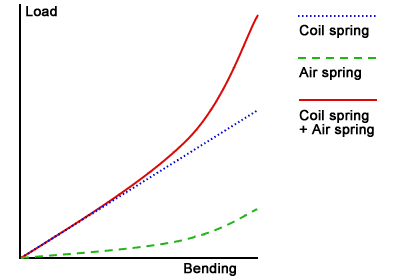
The most difficult part of understanding oil height tuning is that it controls the air spring inside the fork and as such it needs to be tuned with respect to changing load, not fork motion. For example, under very hard braking, almost 100% of the weight of the bike will be held up by the front end. The fork compresses under this increased load, seeking equilibrium. Because of the reduced air volume in the fork, the air must compress, making the rate of this air spring increase at some exponential. By adjusting the oil height, the exact amount of rate can be made available to soak up bumps while under very hard braking. If the fork is bottoming under hard braking, the oil height will need to be raised. If the fork is not still soaking up bumps in this situation, oil height will need to be lowered. If the fork is bottoming from square edged bumps, while not under braking, the shims at the back of the stack should be changed.

(From Honda HRC Setup Guide)
Oil height is the final adjustment to make in the general tuning of the front suspension. In general, a racer will want the suspension to just bottom at least once on a given rough course, this ensures that full travel is being used. Street riders will keep a few millimeters on preserve for huge potholes and the unknown.
Increments should be no more than 2-3mm at a time. Oil can be added to the fork while it is in place on the bike just by removing the top caps. Since the height cannot be measured when the fork is on the bike, note the starting height and add by cc's. The volume of cc's can be approximated to mm of oil height by mm=cc/(Pi*r^2) when r is the radius of the inside of the fork tube. Next time the fork is of the bike, re-measure the oil height. This is the new oil height.
Whenever possible, know what volume of oil you are running in your fork to achive the desired height. By draining oil out the bottom of the fork via the slow speed compression adjuster and refilling through the cap, you can oil tune very rapidly compared to a full fork dissassembly. For the racer, this is a MUST. If this oil tuning is being done for reasons other than temperature change, you may have to decrease the height when using a thicker oil and vis-a-vis
The reason for first setting the oil height to the minimum allowable height will sound odd to many at first glance. The oil height of a fork effectively controls a progressive air spring inside the fork. The less air inside the fork (ie. more oil), the quicker the air spring will ramp up it's effectiveness and the more powerful it will be at the last part of the travel. Stock oil heights are established to ensure that an under sprung fork will never bottom even under the hardest conditions and the heaviest loads. When performance tuning, we know exactly who is going to be on the bike and the conditions that it will be used. Oil height tunes how the bike is sprung during hard, prolonged brakeing. Ususally, the springs in the fork are changed when setting the bike up, so the oil height needs to be changed as well. We do not want a bogus oil height to effect the spring and damper tuning. In the last step in the general tuning of the fork, oil height will be raised, to support the bike under hard braking, only if necessary.
To establish the minimum oil height the goal is to ensure that the fork will have, at all times, the proper amount of lubrication and fluid available for all of it's components. Theoretically, on RSU (right side up) or USD (up side down) forks, oil needs to rise above the top of the damper a distance equal to the length of the top out spring, while the fork, spring, and damper are at full extension. Once the oil is at this point, collapse the fork and damper and measure the oil height in the traditional manner. This is our theoretical minimum oil height that cannot be passed. The difficulty is getting the height to the correct range.
For track use, ride the bike at a moderate speed and grab enough front brake so that the rear wheel is just coming off the ground. You are not trying to do a nose wheelie, just stopping as quickly as possible using just the front brake. A bit of compression damping is good for this since you do not want the fork flying too far past equalibrium. You should not bottom, but uses up just about all of your fork travel. The oil lock piece should be removed. Add oil to prevent bottoming, remove oil for more travel.
For street, things are more difficult. You will need to start, just as above, but then work up to braking in a fashion and over bumps the size that you will encounter on most of your street rides. You want to use almost all your travel while braking extremely hard over bumps, without bottoming. The oil lock peice is good to have in place for street, but can cause some difficulty in knowing if the height is right or if the bottoming is being prevented by the lock. Try to focus on how well the wheel tracks while hard braking. If it feels like the wheel is going ridgid, you may have to actually add oil.
Street is very difficult to tune for since it has so many variables that the track does not. You will probably never get it just right, but understand well how you are compromised.
This site has not been
updated since Fall 2006.
Since then, all new projects
have been place on my wiki
site.
If you like what you see on
this site, Make sure to go
to the wiki for even better
projects.